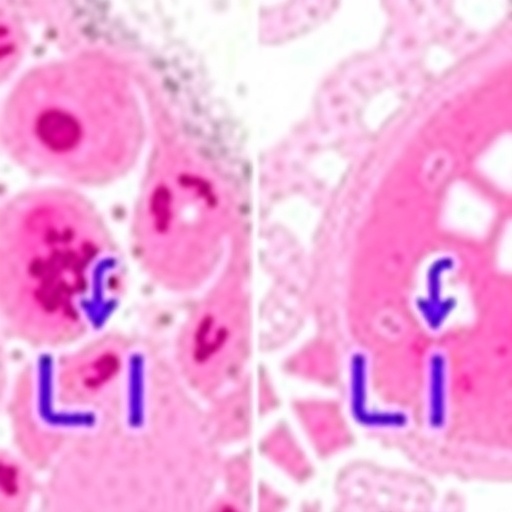In a groundbreaking study published in the upcoming volume of BMC Cancer, researchers have unveiled compelling insights into the multifaceted role of the long non-coding RNA ACOXL-AS1 across a variety of cancers, with a striking focus on its suppressive impact in endometrial endometrioid carcinoma (EEC). This comprehensive investigation not only charts the pan-cancer expression landscape of ACOXL-AS1 but also deciphers its critical functional implications in tumor biology, potentially heralding new frontiers in prognostic and therapeutic strategies.
Long non-coding RNAs (lncRNAs) have emerged as pivotal regulators in carcinogenesis, orchestrating gene expression at multiple levels without translating into proteins. Among these, ACOXL-AS1 has remained enigmatic with respect to its systemic roles across malignancies until the present study, which leveraged expansive datasets from The Cancer Genome Atlas (TCGA) and the Genotype-Tissue Expression (GTEx) project to map its expression and clinical associations. The authors report a consistent downregulation of ACOXL-AS1 in the majority of cancer types examined, correlating robustly with better patient survival outcomes when its expression is elevated.
Delving into clinical correlations, high levels of ACOXL-AS1 were notably linked with favorable tumor characteristics such as reduced size, early disease staging, and diminished metastatic burden. Intriguingly, the study also highlights a significant inverse relationship between ACOXL-AS1 expression and genomic instability markers such as tumor mutational burden (TMB) and microsatellite instability (MSI), which are often implicated in cancer aggressiveness and therapeutic resistance. This positions ACOXL-AS1 as a potential guardian against genomic chaos in tumor cells.
The tumor microenvironment (TME), a dynamic ecosystem comprising immune and stromal components, is increasingly recognized as a determinant of cancer progression and response to treatment. ACOXL-AS1 was found to modulate this immunosuppressive milieu, suggesting that its regulatory effects extend beyond tumor cells themselves and into shaping the inflammatory and immune contexture that influences tumor fate.
Functional assays in vitro using established EEC cell lines HHUA and HEC-1 A reinforced the bioinformatics findings. Lentiviral overexpression of ACOXL-AS1 curtailed cell proliferation, clonogenic potential, and invasive behavior significantly, delineating a clear tumor-suppressive phenotype. These effects were not merely confined to culture conditions; xenograft models further validated that ACOXL-AS1 dampens tumor growth in vivo, underscoring its translational relevance.
Mechanistically, the study sheds light on an intriguing pathway through which ACOXL-AS1 exerts its effects. Bioinformatic integrative analyses predict regulatory interactions involving ACOXL-AS1 and RPA4, a key player in DNA replication and repair via the homologous recombination pathway. This suggests that ACOXL-AS1 may contribute to maintaining genomic integrity by influencing DNA repair mechanisms, preventing unchecked proliferation driven by mutagenic errors common in cancer cells.
The suppressive role of ACOXL-AS1 in EEC also hints at its utility as a prognostic biomarker. The consistent correlation between higher ACOXL-AS1 expression and better clinical parameters implies that its measurement could enhance current risk stratification methods, aiding personalized management decisions. Given the prevalence and mortality associated with endometrial cancers, such biomarkers bear immense clinical significance.
Besides prognostication, the therapeutic implications of manipulating lncRNAs like ACOXL-AS1 are profound. This study opens avenues for RNA-based therapeutics designed to restore or mimic tumor suppressor lncRNAs, potentially overcoming resistance encountered with conventional treatments. Targeting ACOXL-AS1 or its downstream effectors in the homologous recombination pathway could synergistically augment existing therapeutic regimens.
Notably, the pan-cancer framework of the study highlights the broader applicability of ACOXL-AS1 beyond EEC. Although distinct tumor types exhibit unique molecular landscapes, the conserved pattern of ACOXL-AS1 downregulation and its association with favorable prognostic metrics encourages exploration into its roles in other malignancies. Such cross-cancer insights are vital for identifying universal targets in oncology.
Furthermore, integrating multi-omics data encompassing transcriptomics, clinical features, and tumor immunology enriches our understanding of lncRNA functions in complex biological systems. The study exemplifies the power of computational biology combined with rigorous experimental validation, providing a model for future cancer research endeavors.
The immunomodulatory effects observed suggest that ACOXL-AS1 might play a role in tumor immune evasion mechanisms. Deciphering how this lncRNA influences immune cell infiltration, checkpoint molecule expression, or cytokine profiles could illuminate novel immunotherapeutic strategies, a frontier rapidly reshaping cancer treatment paradigms.
In conclusion, the revelations about ACOXL-AS1’s tumor suppressive properties reshape our understanding of non-coding RNA biology in cancer and unveil promising investigative and clinical horizons. As the cancer research community continues to unravel the complexities of the non-coding genome, molecules like ACOXL-AS1 stand out as beacons of hope for more precise, effective interventions.
This seminal work by Wu, Lin, and Hong serves as a clarion call to further dissect lncRNAs’ intricate roles and harness their potential to revolutionize cancer diagnosis and therapy. Future efforts should aim at clinical trials translating these molecular insights into actionable treatment options, ultimately improving patient outcomes on a broad scale.
Together, these findings underscore a paradigm shift, emphasizing the critical importance of non-protein-coding elements in tumorigenesis and offering new tools in the fight against cancer. The landscape of oncology is poised for transformation as ACOXL-AS1 and related lncRNAs enter the spotlight of molecular medicine.
Subject of Research: The pan-cancer expression patterns, prognostic significance, and functional role of the long non-coding RNA ACOXL-AS1, with a focus on its tumor suppressor effects in endometrial endometrioid carcinoma.
Article Title: ACOXL-AS1’s pan-cancer dynamics and its proliferative impact on endometrial endometrioid carcinoma
Article References:
Wu, H., Lin, R. & Hong, L. ACOXL-AS1’s pan-cancer dynamics and its proliferative impact on endometrial endometrioid carcinoma. BMC Cancer 25, 1522 (2025). https://doi.org/10.1186/s12885-025-15005-y
Image Credits: Scienmag.com
DOI: https://doi.org/10.1186/s12885-025-15005-y
Tags: ACOXL-AS1 downregulationACOXL-AS1 expression and survival outcomesACOXL-AS1 role in cancercancer prognosis and therapyclinical implications of ACOXL-AS1endometrioid carcinoma and ACOXL-AS1expression landscape of ACOXL-AS1lncRNAs in malignancieslong non-coding RNA in endometrial carcinomapan-cancer gene expressiontumor biology and lncRNAstumor characteristics and lncRNA levels





